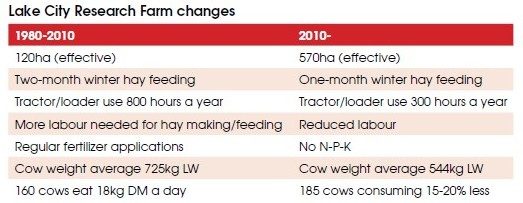Lynda Gray
Reduced inputs, including the elimination of N-P-K fertiliser, while increasing utilisation by 35% over five years were the big paybacks of a regenerative grazing management system for cattle run at a Michigan State University research farm.
The wins were overviewed at the second day of the World Hereford Conference by Jason Rowntree, Associate Professor of Animal Science at Michigan State University (MSU).
“We are enjoying 35% more stock days an acre or cow days an acre, meaning I am harvesting 35% more grass than what I did prior.”
During a woolshed presentation at Earnscleugh Station near Alexandra he told delegates about the transformation of the 120-hectare research cattle breeding and finishing farm at Lake City from a traditional grass system to a regenerative system. The farm had an 890mm rainfall and 3.8 metres of snow a year, and pasture-wise was comparable to extensive farms in the southern South Island.
He defined ‘regenerative’ agriculture as management to enhance and restore a resilient system which supports and is supported by functional ecosystem processes and healthy soils. The regenerative system at Lake City farm was based on adaptive multi-paddock (AMP) grazing, where high density grazing is followed by long periods of recovery for the land.
This type of grazing mimicked the natural grazing patters of wild ruminants, he said, and allowed for a deeper, healthier root system which built organic matter in the soil, and improved moisture retention. A published paper in 2018 reported a 3 tonne/ha soil carbon sequestration across the farm in the four years after transition.
Under the system, applications of N-P-K stopped point blank in 2010, along with anthelmintic drench which was replaced with parasite monitoring. Also, the amount of hay made onfarm was reduced. The area that was set aside for hay was included in the grazing system to increase the effective area.
He said the management was a combination of stock density and appropriate plant recovery tied to a grazing and financial plan.
“We constantly juggle the needs of our yearlings and the needs of the land, using the cows as a tool.”
Aside from the grazing management, genetics were also changed. The cows were downsized with the introduction of Red Angus genetics from 725kg to a 540kg liveweight (LW) average. The productive benefits of downsizing were vindicated by research that showed a 450kg LW cow weaned the most liveweight per hectare.
He wasn’t necessarily pushing for New Zealand beef producers to follow the AMP system and said that from his observations NZ grazing systems were managed to a much higher degree than those in the United States. However, he would be interested to see what types of changes would occur if all the “exogenous nitrogen” was eliminated.
“I think the microbial life of the soil would improve, and that adding greater diversity would improve the land without sacrificing much in production. It would also keep a lot of nitrogen out of your waterways. That’s my hypotheses anyway.”
His message for NZ beef farmers was that they were making society better, not worse.
“I think that through misaligned reductionary science, beef cattle are getting a bad look.”
However, he said when they were in a properly managed grazing system there could be considerable ecosystem benefits while providing a healthful and enjoyable eating experience.
All farmers should be pushing themselves to lower fertiliser inputs and consider adding more diversity to pastures.
“I wish there were mechanisms through industry or the government to soften any short-term financial losses, but I think long-term the approach will be more profitable, especially with emissions restrictions looming.”
Missionaries from abroad
Doug Edmeades
I am getting tired of missionaries arriving on our shores teaching “grandma” (the New Zealand pastoral farmer) to suck eggs! It appears that Dr Jason Rowntree falls into this category. Some of his ramblings are self-contradictory. Some of his advice is dangerous.
He talks about the huge benefits they have had in Michigan, United States, adopting what he calls Adaptive Multi-Paddock (AMP) grazing, a smart-arsed acronym for rotational grazing. He is quoted as saying that “He wasn’t necessarily pushing for NZ beef producers to follow the AMP system.”
He then goes on to do exactly that, repeating some of the dogmatic mantra that is now known as regenerative agriculture – e.g. pasture diversity, enhanced soil microbial life, reducing environmental footprint, improved pasture production etc, ad nauseum.
He is quoted as saying that from his observations “… New Zealand grazing systems were managed to a much higher degree than those in the United States” I wonder if it occurred to him that NZ pastoral farmers pioneered the use of rotational grazing back in the mid 1950s. Of course, we do it better!
He tells us that under the AMP system applications of fertilisers “stopped point blank in 2010.” He advises us: “I think you should be pushing yourself to lower your fertiliser inputs…” This is regenerative agriculture at its worst and it is seriously dangerous advice.
Remember the 1980s when subsidies on fertiliser were removed? Farmers stopped applying fertiliser and their farms quickly went backwards as the soil fertility levels were mined down. If you do not replace the nutrients in the produce you send off the farm then you are going backwards. It is not sustainable, period!
Everyone is entitled their opinion. The opinions I like are those based in sound science and logical reasoning.




